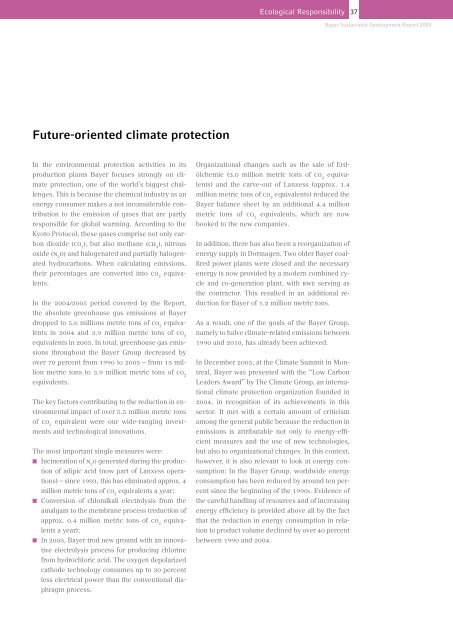Science For A Better Life - Bayer
Science For A Better Life - Bayer
Science For A Better Life - Bayer
Create successful ePaper yourself
Turn your PDF publications into a flip-book with our unique Google optimized e-Paper software.
Future-oriented climate protection<br />
In the environmental protection activities in its<br />
production plants <strong>Bayer</strong> focuses strongly on climate<br />
protection, one of the world’s biggest challenges.<br />
This is because the chemical industry as an<br />
energy consumer makes a not inconsiderable contribution<br />
to the emission of gases that are partly<br />
responsible for global warming. According to the<br />
Kyoto Protocol, these gases comprise not only carbon<br />
dioxide (co 2 ), but also methane (ch 4 ), nitrous<br />
oxide (n 2 o) and halogenated and partially halogenated<br />
hydrocarbons. When calculating emissions,<br />
their percentages are converted into co 2 equivalents.<br />
In the 2004/2005 period covered by the Report,<br />
the absolute greenhouse gas emissions at <strong>Bayer</strong><br />
dropped to 5.6 millions metric tons of co 2 equivalents<br />
in 2004 and 3.9 million metric tons of co 2<br />
equivalents in 2005. In total, greenhouse gas emissions<br />
throughout the <strong>Bayer</strong> Group decreased by<br />
over 70 percent from 1990 to 2005 – from 15 million<br />
metric tons to 3.9 million metric tons of co 2<br />
equivalents.<br />
The key factors contributing to the reduction in environmental<br />
impact of over 5.5 million metric tons<br />
of co 2 equivalent were our wide-ranging investments<br />
and technological innovations.<br />
The most important single measures were:<br />
� Incineration of n 2 o generated during the production<br />
of adipic acid (now part of Lanxess operations)<br />
– since 1993, this has eliminated approx. 4<br />
million metric tons of co 2 equivalents a year;<br />
� Conversion of chloralkali electrolysis from the<br />
amalgam to the membrane process (reduction of<br />
approx. 0.4 million metric tons of co 2 equivalents<br />
a year);<br />
� In 2003, <strong>Bayer</strong> trod new ground with an innovative<br />
electrolysis process for producing chlorine<br />
from hydrochloric acid. The oxygen depolarized<br />
cathode technology consumes up to 30 percent<br />
less electrical power than the conventional diaphragm<br />
process.<br />
Ecological Responsibility<br />
Organizational changes such as the sale of Erdölchemie<br />
(3.0 million metric tons of co 2 equivalents)<br />
and the carve-out of Lanxess (approx. 1.4<br />
million metric tons of co 2 equivalents) reduced the<br />
<strong>Bayer</strong> balance sheet by an additional 4.4 million<br />
metric tons of co 2 equivalents, which are now<br />
booked to the new companies.<br />
In addition, there has also been a reorganization of<br />
energy supply in Dormagen. Two older <strong>Bayer</strong> coalfired<br />
power plants were closed and the necessary<br />
energy is now provided by a modern combined cycle<br />
and co-generation plant, with rwe serving as<br />
the contractor. This resulted in an additional reduction<br />
for <strong>Bayer</strong> of 1.2 million metric tons.<br />
As a result, one of the goals of the <strong>Bayer</strong> Group,<br />
namely to halve climate-related emissions between<br />
1990 and 2010, has already been achieved.<br />
In December 2005, at the Climate Summit in Montreal,<br />
<strong>Bayer</strong> was presented with the “Low Carbon<br />
Leaders Award” by The Climate Group, an international<br />
climate protection organization founded in<br />
2004, in recognition of its achievements in this<br />
sector. It met with a certain amount of criticism<br />
among the general public because the reduction in<br />
emissions is attributable not only to energy-efficient<br />
measures and the use of new technologies,<br />
but also to organizational changes. In this context,<br />
however, it is also relevant to look at energy consumption:<br />
In the <strong>Bayer</strong> Group, worldwide energy<br />
consumption has been reduced by around ten percent<br />
since the beginning of the 1990s. Evidence of<br />
the careful handling of resources and of increasing<br />
energy efficiency is provided above all by the fact<br />
that the reduction in energy consumption in relation<br />
to product volume declined by over 40 percent<br />
between 1990 and 2004.<br />
37<br />
<strong>Bayer</strong> Sustainable Development Report 2005


